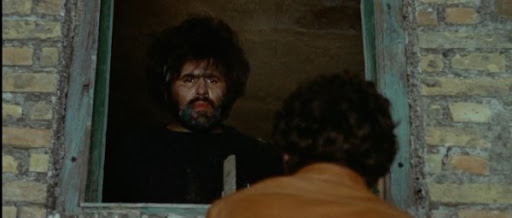| "And after I catch the baddie...you wanna go to a disco?" |
1) With his beige turtleneck, matching sports jacket and massive jew-fro, Tony Musante could never be the hero of a film in the modern age.
2) Given how much Dario Argento becomes known for grotesque images, it's interesting how...staid the set pieces are in his first film. There's only one real violent murder sequence, with the others utilizing sound, mood and other tricks to get their points across. And the fact that the film's solution revolves around a mistake in perception--a mistake similar to the one made by the killer before the carnage begins--makes us think that Argento could have been a much different filmmaker if things were different.
3) That being said...it's comforting to know that, on Argento world, the police have always been clueless. Even when they utilize what was for 1970 'cutting edge computer technology,' they're lucky Musante was on the scene to save their asses.
 |
| "Come on in. I just put the cat in the oven." |
4) Also comforting is how Argento has this love of bizarre human beings that bear no resemblance to actual human beings. The painter who, unbeknownst to anyone, is key to the mystery with a taste for cats and a hatred of doors could only exist in the movies.
5) Looking back at what is now called 'The Animal Trilogy,' of which this is the first, they're actually three variations on the same story, right down to the nature of the third act's final reveal..
6) Even back then....Argento's world is not women friendly. You could replace Suzy Kendall's Julia with a particularly intelligent dog with no change to the story.
7) There's something truly creepy about the ultimate killer, whose screen time is usually punctuated solely by halting giggling, and has a posture and movement like a great cat.
 |
| "Maaaaria...I just met a killer named Maria..." |
8) I love how non-plussed old ladies are by a gloved, trenchcoated killer trying to decapitate a man with a meat clever in Argento's World.
9) You can still see the seeds of what will become Argento World's most notorious tropes in this film--the bright colors (one sequence involves a man in a yellow windbreaker so bright it practically glows), the lack of logic (it's obvious that Argento is reaching when it comes time to explain why exactly the killer went around slicing people up), the main character with the strange confidante, the artistic pursuit of the hero, etc.
10) Perhaps the most intriguing sequence involves Julia being stalked by the killer in her own home. At one point, Argento simply focuses on a yellow window in the lower left hand corner, plunging the rest of the room in darkness and letting the sounds tell the story.
Overall...this was the first Argento film I saw when I was younger, and it's still one of my favorite films in his canon. It still holds a punch, even as some of the aspects creates a sense of cheesiness to it's 'modern' 70's style.
No comments:
Post a Comment